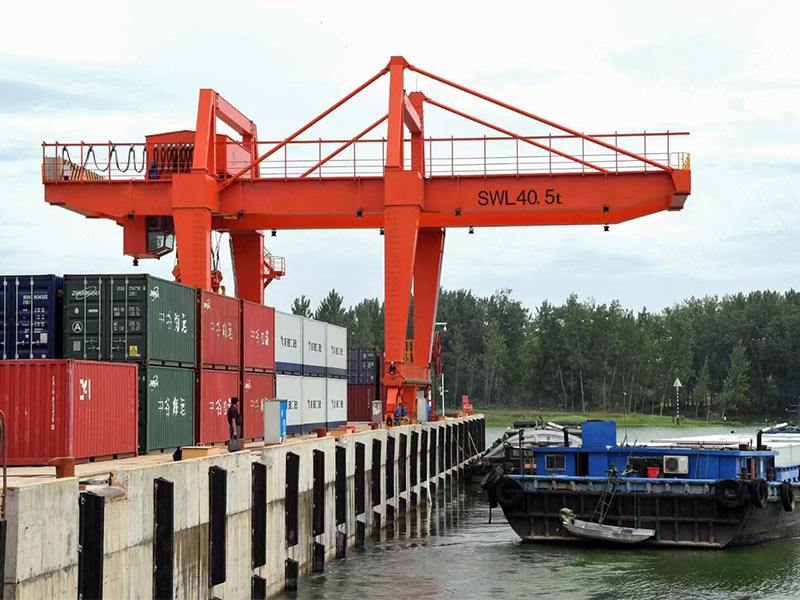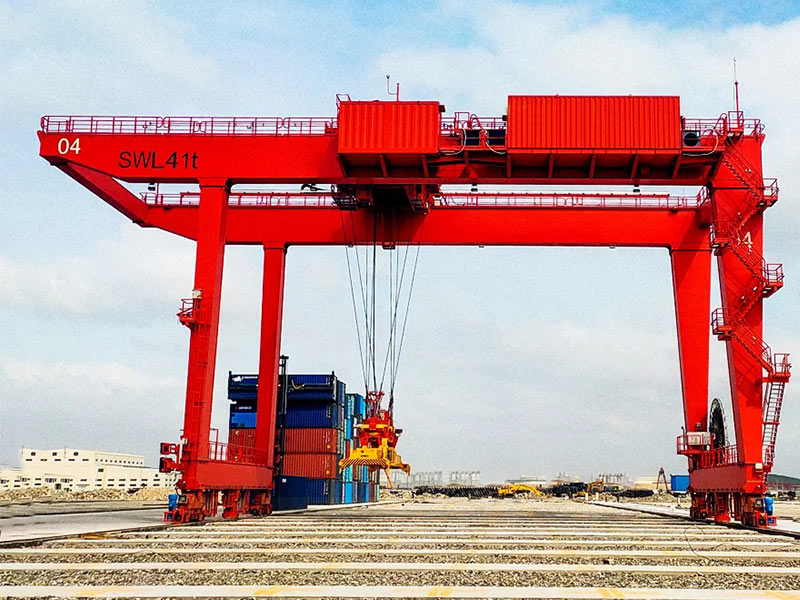Shipping container gantry cranes are essential in the logistics and shipping industries, playing a pivotal role in container handling operations at ports and intermodal facilities. These cranes come in two primary types: fixed and mobile. While both serve the critical function of moving containers, they differ significantly in design, functionality, operational efficiency, and application. In this article, we will explore the differences and advantages of fixed and mobile shipping container gantry cranes, providing insights to help stakeholders make informed decisions for their operations.

Understanding Fixed Shipping Container Gantry Cranes
Fixed shipping container gantry cranes, also known as quay cranes, are typically installed permanently at ports and are designed for large-scale container handling operations. These cranes are mounted on fixed structures and are primarily used for loading and unloading containers from ships. Their design includes a tall, rigid framework that allows them to extend over the vessel’s deck, enabling the efficient transfer of containers.
Advantages of Fixed Gantry Cranes
- High Lifting Capacity: Fixed gantry cranes are designed to handle heavy loads, with lifting capacities often exceeding 100 tons. This makes them suitable for large container vessels that carry significant weights.
- Speed and Efficiency: Due to their permanent installation and robust design, fixed cranes can operate at higher speeds compared to mobile cranes. They can quickly load and unload containers, significantly reducing turnaround times for vessels.
- Stability: The fixed nature of these gantry cranes provides excellent stability during operations. They are designed to handle dynamic loads and adverse weather conditions, ensuring safety and reliability.
- Optimized for High Volume: Fixed gantry cranes are typically used in high-volume container ports, where large quantities of containers need to be moved efficiently. Their ability to handle multiple containers simultaneously enhances operational efficiency.
- Long-Term Investment: While the initial investment is high, fixed gantry cranes offer long-term benefits, including lower operational costs due to their durability and efficiency.

Limitations of Fixed Gantry Cranes
- Lack of Flexibility: Fixed cranes are not mobile, meaning they cannot be relocated to different areas of the port. This limits their utility in scenarios where container handling needs may shift.
- High Initial Costs: The installation of fixed gantry cranes involves significant capital investment, which may be a barrier for smaller ports or companies.
- Space Requirements: Fixed cranes require a substantial amount of space for operation, which may not always be available in densely populated port areas.
Understanding Mobile Shipping Container Gantry Cranes
Mobile shipping container gantry cranes, often referred to as rubber-tired gantry (RTG) cranes or mobile gantry cranes, are designed for flexibility and mobility. These cranes are equipped with wheels or tracks that allow them to move freely around the container yard, making them suitable for various container handling applications.
Advantages of Mobile Gantry Cranes
- Flexibility: The primary advantage of mobile gantry cranes is their ability to move between different areas of a port or terminal. This flexibility allows for efficient handling of containers in various locations, optimizing space usage.
- Lower Initial Costs: Mobile gantry cranes typically require a lower initial investment compared to fixed cranes. This makes them more accessible for smaller operations or ports with limited budgets.
- Space Efficiency: Since they can operate in confined spaces and move around as needed, mobile cranes can be utilized effectively in areas where fixed cranes may not be feasible.
- Adaptability to Changes: Mobile cranes can adapt to changing operational needs, such as fluctuations in container traffic or the introduction of new handling technologies.
- Reduced Infrastructure Requirements: Mobile gantry cranes do not require extensive infrastructure or foundations, leading to reduced setup times and costs.
Limitations of Mobile Gantry Cranes
- Lower Lifting Capacity: Mobile gantry cranes generally have lower lifting capacities than fixed cranes, typically ranging from 30 to 60 tons. This makes them less suitable for handling larger containers or heavy cargo.
- Speed and Efficiency: While mobile cranes offer flexibility, they may not match the speed and efficiency of fixed cranes, particularly in high-volume operations.
- Stability Concerns: The mobility of these cranes can impact stability during operation, especially in adverse weather conditions. Proper training and precautions are necessary to ensure safe operations.
- Higher Operational Costs: Mobile gantry cranes may have higher operational costs in the long run due to their maintenance requirements and potential fuel consumption.
Comparing Operational Efficiency
When comparing the operational efficiency of fixed and mobile shipping container gantry cranes, it’s essential to consider the context in which they are used. Fixed gantry cranes excel in high-volume port environments where large ships frequently dock. Their ability to quickly load and unload containers allows for efficient vessel turnaround, contributing to overall port productivity.
In contrast, mobile gantry cranes are more suitable for facilities with variable container handling needs, such as intermodal terminals or smaller ports. Their adaptability allows operators to optimize container movement based on fluctuating demands and space constraints. To learn more about gantry cranes, visit website: https://aicraneliftingsolution.com/gantry-cranes/
Choosing the Right Crane for Your Operation
The decision to invest in fixed or mobile shipping container gantry cranes depends on various factors, including:
- Operational Needs: Evaluate the volume of containers to be handled, the types of vessels serviced, and the layout of the port or terminal.
- Budget: Consider initial investment costs, ongoing operational expenses, and potential return on investment over time.
- Space Availability: Assess the physical space available for crane operation, as well as future expansion plans.
- Flexibility Requirements: Determine the need for mobility versus the advantages of fixed, high-capacity operations.
Conclusion
In summary, both fixed and mobile shipping container gantry cranes play vital roles in container handling operations, each with distinct advantages and limitations. Fixed gantry cranes provide high lifting capacities, speed, and stability, making them ideal for large-scale port operations. On the other hand, mobile gantry cranes offer flexibility, lower initial costs, and adaptability, making them suitable for a wide range of applications.
Ultimately, the choice between fixed and mobile gantry cranes should be based on a thorough analysis of operational requirements, budget constraints, and long-term strategic goals. By understanding the unique features and capabilities of each type, stakeholders can make informed decisions that enhance efficiency, productivity, and profitability in their container handling operations.